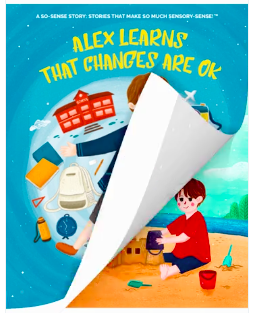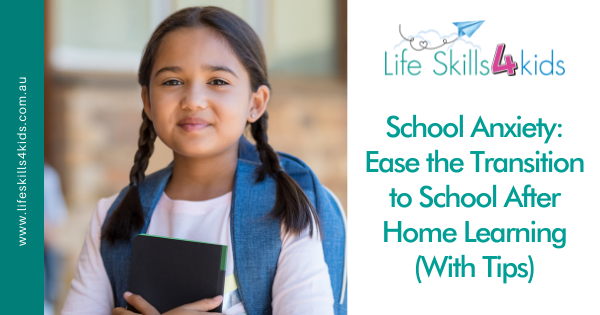School anxiety after home learning is to be expected. For many students, it has been a long time since they were last in a classroom, and with the uncertainty of lockdowns and the world in general, many children and young people have anxiety about returning to the classroom.
This can be especially worrying for children whose siblings may be starting on a different date as schools stagger the return to school.
So, what does school anxiety look like, and how can you help your child to manage it?
Sometimes labelled as school refusal
Children who cannot face school because of their anxiety issues are sometimes labelled as school refusers, which is not helpful and doesn’t address the root cause of the problem. Authorities may also place pressure on parents to force kids to attend school, which adds to their stress and anxiety.
But blame and an authoritarian approach are not the best solutions to this problem. We’ll get to that. Let’s just take a moment to consider what school anxiety looks like.
- Internalising, becoming withdrawn
- Distress over normal events or morning chores
- Meltdowns
- Easily distracted, can’t focus
- Tearfulness
- Freezing at the door
- Quiet
- Mystery aches and pains
- Holding it together at school but negative behaviour at home
- Disruptive or destructive behaviour in the classroom
- Hiding
- Refusal to attend school no matter what
In the case of a student whose siblings are starting on a different date after a long period of home learning, school anxiety can be even worse, especially if they usually go to school together or see each other throughout the day. The student at school may feel more alone or vulnerable than usual, while the one still at home may have a lot of worries and fears for the sibling at school and for their own return to school on their allocated date.
So, how can parents ease the transition to school when students may be starting at different times?
Tips to help kids manage school anxiety when start dates are different
When one child is resuming face-to-face learning and others are still at home, it can be daunting and create anxiety. Try these tips to help with school anxiety and their worries around different starting dates.
Visual reminders of starting dates
Many families find it helpful to keep a calendar of the start dates for school or other important dates. You can have a calendar for the whole family to use and a separate one for each child. When your child starts to feel anxious about what’s going to happen, you can remind them to look at the calendar. Teach them to do this as a way of managing their anxiety.
Timetables
Another handy tool for anxious children left at home is knowing the timetable of a sibling who has returned to school. When they start to get anxious or worried about the sibling, you can show them the timetable and talk about what their sibling might be doing at that moment.
Focus on the known
Children often focus on the fear that the unknown brings. Will things still be the same at school? Will the classroom look the same? Will they still have the same desk and chair?
Rather than worrying about the unknown, help your child to focus on the things they do know. Look at the calendar with the start date on it and talk about returning to school on that date. Talk about the teacher if you’re sure it will be the same person. Help your child to remember the school routine, such as class time and playtime. Remind them that lots of the things that were familiar at school will be the same.
Look for the positives
Rather than getting caught in a cycle of worry and fear, look for the positives in returning to school. There is always something positive in any situation, and many things to be thankful for when you look for them.
Encourage your child to think of the things that are good about school. Will they be seeing a special friend again? Do they enjoy playing at recess? Is there a subject they like, such as art or music?
Help your child focus on the good things about school and enjoy the benefits of positive feelings instead of stress and worry.
Provide noise alleviation
Sometimes excessive noise causes school anxiety, especially for children with autism or sensory processing disorder.
If noise is the reason a child is anxious, you can send them to school with ear protection to minimise the noise. It’s best to discuss this with the teachers first so they can help your child manage while you’re not there.
Make home a calming experience
When a child comes home after a long day of school experiences, it’s essential to help them relax. Spend some time out in nature together. Take the dog for a walk or do some gardening. Go for a bike ride or a swim to get their muscles moving. Play with a pet, or listen to calming music together.
Creating calming experiences will look different for each family, but it’s important to have something in place so that your child can relax after school.
Set clear expectations of school boundaries and routines
Talk about school expectations before classes resume. Remind your child of the school routine and discuss school boundaries, if appropriate. Each school will have different rules, for example, no throwing sand at other children in the sandpit. No hitting, no swearing, or whatever other rules apply.
A reminder of the rules can be helpful because sometimes children break the rules without thinking. They then fear getting into trouble, so setting clear expectations around rules and behaviour can help alleviate anxiety.
Play games for distraction
Sometimes distractions are just what you need to prevent anxiety-induced meltdowns or tearfulness. Play an “I Spy” game on the way to school, or pick out favourite local landmarks. Try an imagination game about who might live in an unusual house, or think of something quirky such as what the animals in the zoo might say when they see all the people. Use your imagination and have some fun.
Get moving
Movement is so important for mood and wellbeing, and doing it with your child can make you both feel good. Set aside a regular time to get moving. You could put on a dance DVD and do all the moves together, go for a walk outside in the fresh air, play at the park, or ride your bikes.
Provide a safe place for your child to unload their worries and fears
One of the most important things you can do it provide a safe space where your child can unload their worries and fears without judgment, criciticism, or blame. Encourage your child to talk about their day and the things that went well and the things that didn’t. Talk about how they might be able to do things differently next time (it helps to build resilience), and think of ways to solve problems they might be facing.
School anxiety doesn’t have to control your life
School anxiety might be crippling, but it doesn’t have to control your life or your child’s. Try some of the strategies above, be understanding and encouraging, and help your child to thrive in spite of the challenges.
For more updates, follow us on our social media channels. We are on Facebook, Twitter, Linkedin, and Instagram!
Get your own copy!
Alex loves school. He enjoys all the activities he does during the term such as swimming and soccer. He also loves holidays and all the fun things he gets to do while he’s not at school. The problem is, Alex doesn’t like changes. His tummy gets all tight and he gets a worry cloud that comes over his brain and makes it feel foggy. When the school term ends and holidays begin or when school is about to start again, Alex feels really worried and anxious.
Alex Learns that Changes Are Okay is a beautiful book for children who find change difficult.
When you purchase the Alex Learns that Changes are OK (Flipbook), you will receive a digital flipbook that gradually changes from one page to the next while listening to high-quality audio narration as if someone is flipping and reading the book for you!


